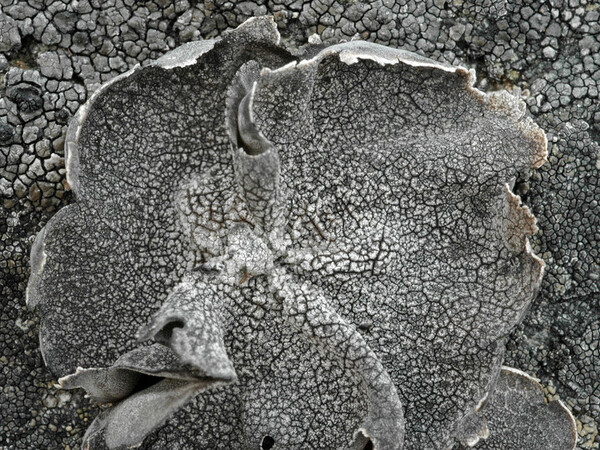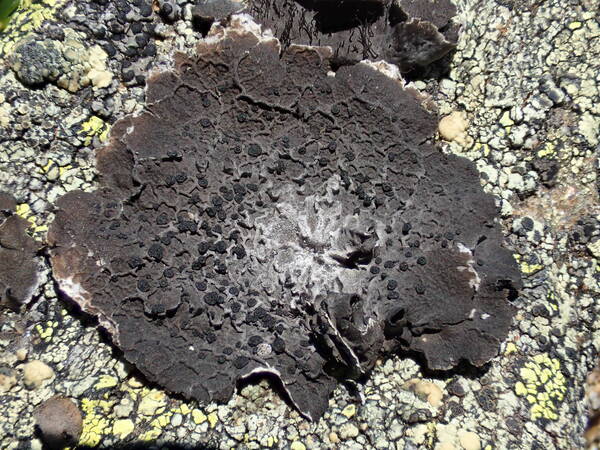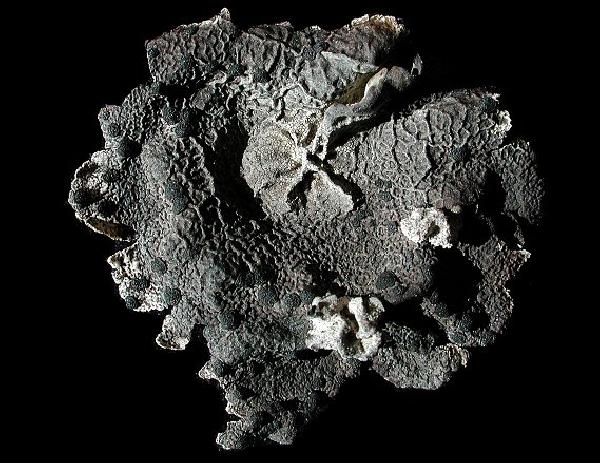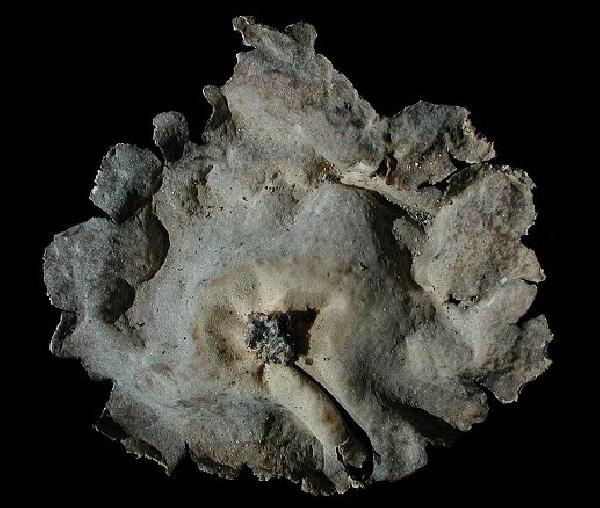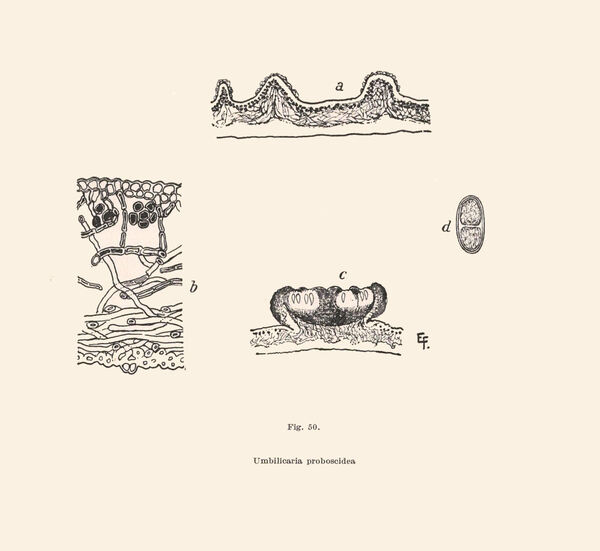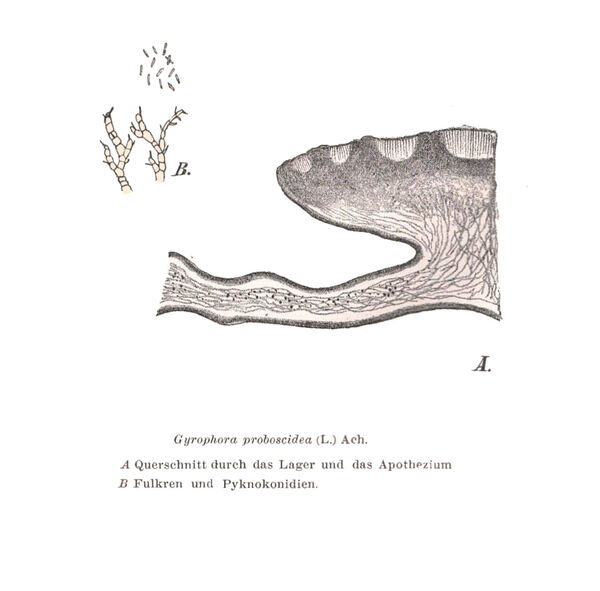Umbilicaria proboscidea (L.) Schrad.
Spicil. Fl. Germ., 1: 103, 1794. Basionym: Lichen proboscideus L. - Sp. Pl., 2: 1150, 1753.
Synonyms: Gyrophora polymorpha var. proboscidea (L.) Schaer.; Gyrophora proboscidea (L.) Ach.
Distribution: N - TAA (Nascimbene 2003, Nascimbene & al. 2022), Lomb, Piem (Tretiach 1993, Isocrono & al. 2004), VA (Piervittori & al. 1998, Piervittori & Isocrono 1999, Watson 2014).
Description: Thallus foliose-umbilicate, heteromerous, dorsiventral, monophyllous, thin and fragile, strongly adpressed, orbicular or elliptic in outline, 2-5(-8) cm diam., with lacerate, shallowly incised, slightly up-turned margins, attached by a central holdfast. Upper surface dark brown to black, dull, with a reticulate pattern of ridges over the umbilicus, fading to vermiform ridges toward the margins, the central umbo raised and often white-pruinose. Lower surface pale brown, darker toward margins, even or with shallow depression around umbilicus, usually erhizinate or rarely with a few simple or sparsely branched rhizinomorphs; thalloconidia absent. Upper cortex 8-16 µm thick: medulla white, loose; lower cortex paraplectenchymatous, 14-24 µm thick. Apothecia rather rare, black, gyrodisc, sessile, to 1.5 mm across. Epithecium brown-black; hymenium colourless; paraphyses simple or sparingly branched, the terminal cells hardly swollen; hypothecium dark. Asci 8-spored, clavate, thick-walled, with an amyloid apical dome, Umbilicaria-type. Ascospores 1-celled hyaline, ovoid, (10-)12-15(-17) x (3.5-)5-7.5 µm. Photobiont chlorococcoid. Spot tests: medulla K- or K+ yellow turning red, C+ red, KC+ red, P- or P+ faintly yellow. Chemistry: medulla with variable amounts of norstictic acid, plus gyrophoric and lecanoric acids.Note: a mainly arctic-alpine, circumpolar lichen found on siliceous rocks, often on small boulders, ecologically similar to U. cylindrica, but with a narrower range, with optimum in colder and less continental areas above treeline.
Growth form: Foliose, umbilicate
Substrata: rocks
Photobiont: green algae other than Trentepohlia
Reproductive strategy: mainly sexual
Commonnes-rarity: (info)
Alpine belt: rather common
Subalpine belt: rare
Oromediterranean belt: absent
Montane belt: absent
Submediterranean belt: absent
Padanian area: absent
Humid submediterranean belt: absent
Humid mediterranean belt: absent
Dry mediterranean belt: absent
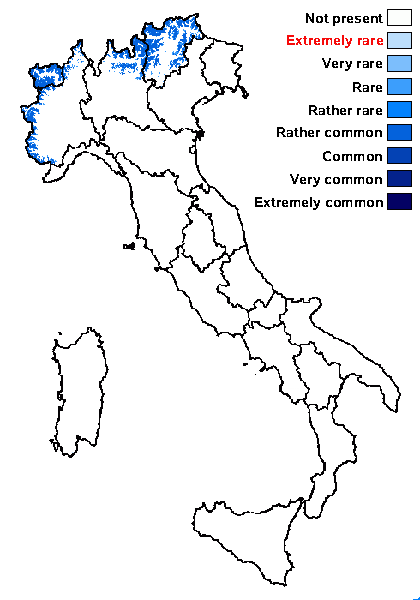
Predictive model
Herbarium samples


P.L. Nimis; Owner: Department of Life Sciences, University of Trieste
Herbarium: TSB (14270)
2003/03/17
lower surface
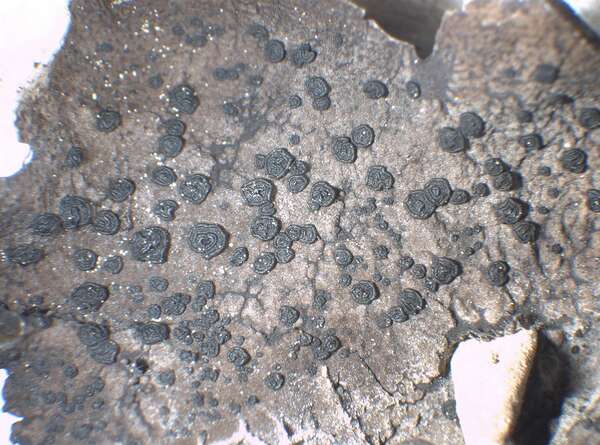

P.L. Nimis; Owner: Department of Life Sciences, University of Trieste
Herbarium: TSB (14270)
2003/03/17
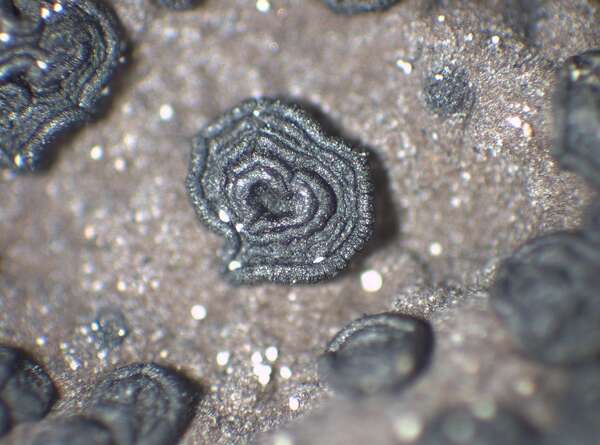

P.L. Nimis; Owner: Department of Life Sciences, University of Trieste
Herbarium: TSB (14270)
2003/03/17
apothecium


P.L. Nimis; Owner: Department of Life Sciences, University of Trieste
Herbarium: TSB (11076)
2001/12/05
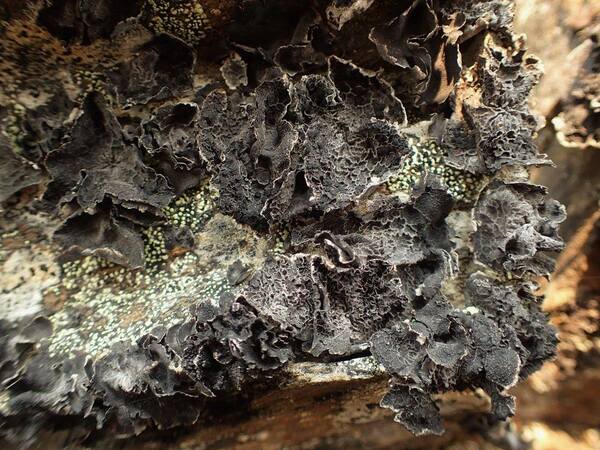

Curtis Randall Björk, - CC BY-SA 4.0
Sugarbowl-Grizzly Den Provincial Park, British Columbia, Canada
September 2017
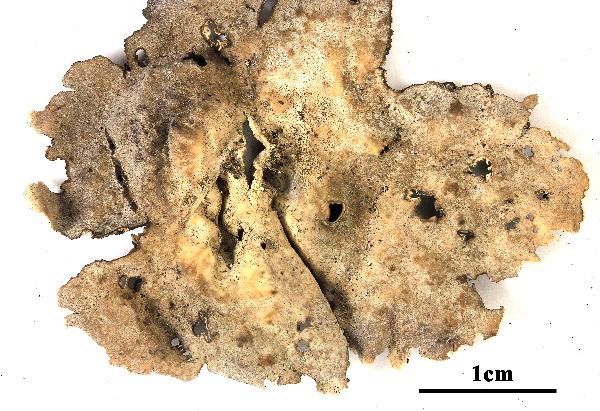

Felix Schumm - CC BY 4.0
[KU196], Japan. Honshu. Prov. Shinano: Mt. Kimpu, Minami-Sakugun.
On rocks, 2550 m. Leg. H. Shibuichi (no.4668) and K. Yoshida,
Umbilicaria


Felix Schumm - CC BY 4.0
[KU196], Japan. Honshu. Prov. Shinano: Mt. Kimpu, Minami-Sakugun.
On rocks, 2550 m. Leg. H. Shibuichi (no.4668) and K. Yoshida,
Umbilicaria
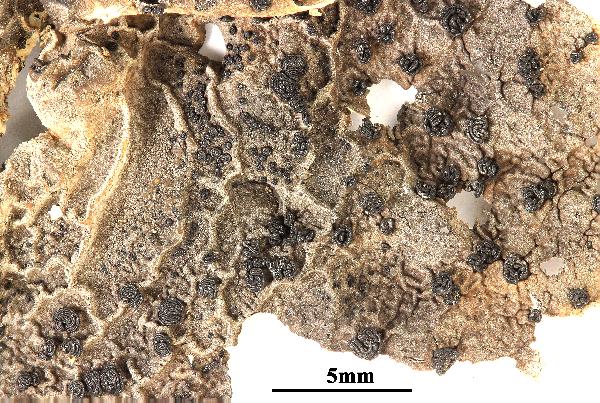

Felix Schumm - CC BY 4.0
[KU196], Japan. Honshu. Prov. Shinano: Mt. Kimpu, Minami-Sakugun.
On rocks, 2550 m. Leg. H. Shibuichi (no.4668) and K. Yoshida,
Umbilicaria


Felix Schumm - CC BY 4.0
[KU250], Japan. Hokkaido. Prov. Ishikari: Southern slope of Mt. Akadake,
Daisetsu Mts. On rock, 2000 m. Leg. S. Kurokawa (no. 71133),
3.09.1971, det. S. Kurokawa. EX S. KUROKAWA: LICHENES RARIORES
ET CRITICI EXSICCATI NR. 250.
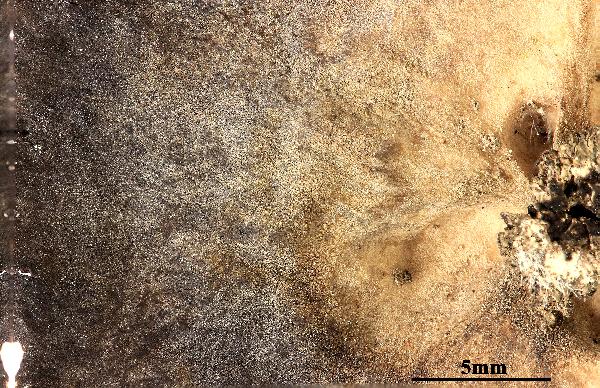

Felix Schumm - CC BY 4.0
[KU250], Japan. Hokkaido. Prov. Ishikari: Southern slope of Mt. Akadake,
Daisetsu Mts. On rock, 2000 m. Leg. S. Kurokawa (no. 71133),
3.09.1971, det. S. Kurokawa. EX S. KUROKAWA: LICHENES RARIORES
ET CRITICI EXSICCATI NR. 250.
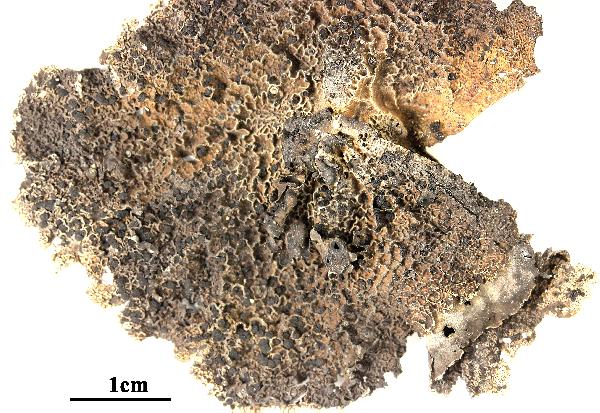

Felix Schumm - CC BY 4.0
[KU250], Japan. Hokkaido. Prov. Ishikari: Southern slope of Mt. Akadake,
Daisetsu Mts. On rock, 2000 m. Leg. S. Kurokawa (no. 71133),
3.09.1971, det. S. Kurokawa. EX S. KUROKAWA: LICHENES RARIORES
ET CRITICI EXSICCATI NR. 250.
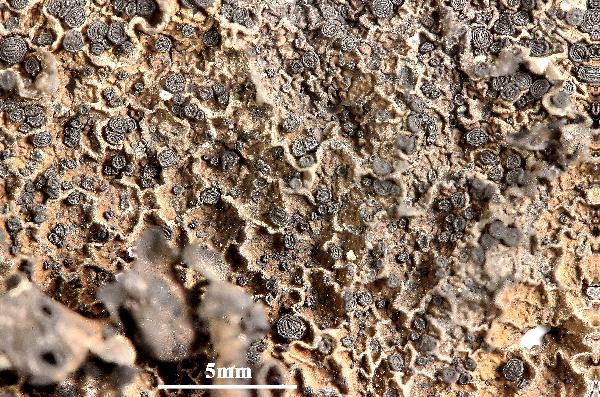

Felix Schumm - CC BY 4.0
[KU250], Japan. Hokkaido. Prov. Ishikari: Southern slope of Mt. Akadake,
Daisetsu Mts. On rock, 2000 m. Leg. S. Kurokawa (no. 71133),
3.09.1971, det. S. Kurokawa. EX S. KUROKAWA: LICHENES RARIORES
ET CRITICI EXSICCATI NR. 250.
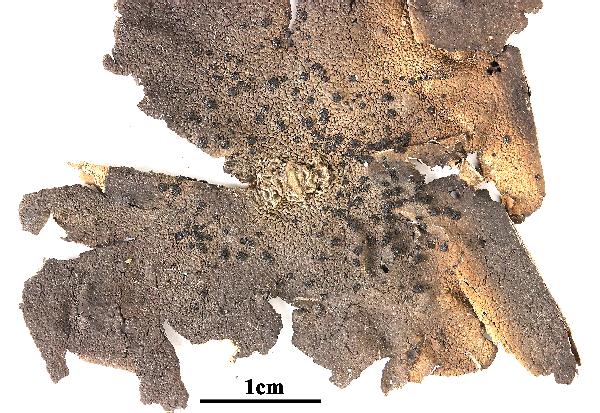

Felix Schumm - CC BY 4.0
[KU543], Japan. Honshu. Prov. Musashi. Mt. Ohyama, near Jumonji
pass, Chichibu-gun. On rocks, 2200 m. Leg. K. Yoshida (no. 1619],
08.10.1974, det. H. Kashiwadani. EX S. KUROKAWA AND H. KASHIWADANI:
LICHENES RARIORES ET CRITICI NR. 543.
Thallus
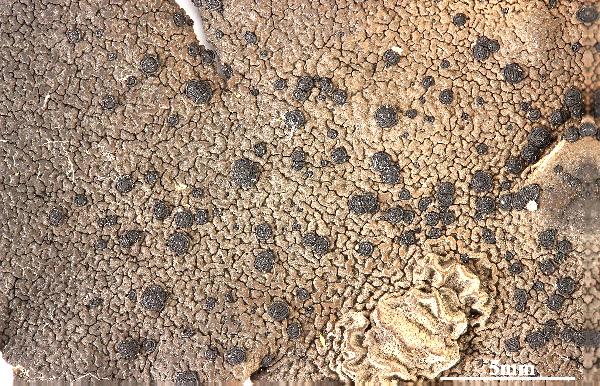

Felix Schumm - CC BY 4.0
[KU543], Japan. Honshu. Prov. Musashi. Mt. Ohyama, near Jumonji
pass, Chichibu-gun. On rocks, 2200 m. Leg. K. Yoshida (no. 1619],
08.10.1974, det. H. Kashiwadani. EX S. KUROKAWA AND H. KASHIWADANI:
LICHENES RARIORES ET CRITICI NR. 543.
Thallus
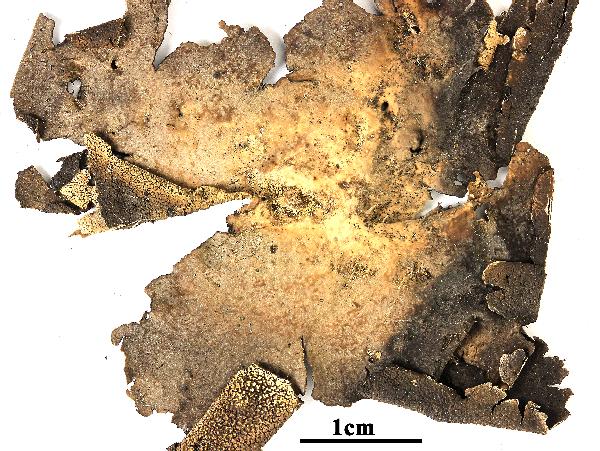

Felix Schumm - CC BY 4.0
[KU543], Japan. Honshu. Prov. Musashi. Mt. Ohyama, near Jumonji
pass, Chichibu-gun. On rocks, 2200 m. Leg. K. Yoshida (no. 1619],
08.10.1974, det. H. Kashiwadani. EX S. KUROKAWA AND H. KASHIWADANI:
LICHENES RARIORES ET CRITICI NR. 543.
Thallus
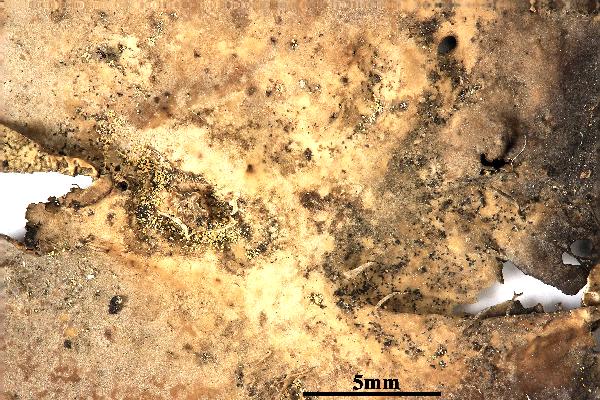

Felix Schumm - CC BY 4.0
[KU543], Japan. Honshu. Prov. Musashi. Mt. Ohyama, near Jumonji
pass, Chichibu-gun. On rocks, 2200 m. Leg. K. Yoshida (no. 1619],
08.10.1974, det. H. Kashiwadani. EX S. KUROKAWA AND H. KASHIWADANI:
LICHENES RARIORES ET CRITICI NR. 543.
Thallus


Felix Schumm - CC BY 4.0
[KU697], Honshu. Prov. Shimotsuke: Mt. Shirane. On rocks, 2570 m.
Leg. H. Shibuichi (no. 6513), 4.08.1981, det. H. Kashiwadani. EX S.
KUROKAWA AND H. KASHIWADANI: LICHENES RARIORES ET CRITICI
EXSICCATI NR. 697.
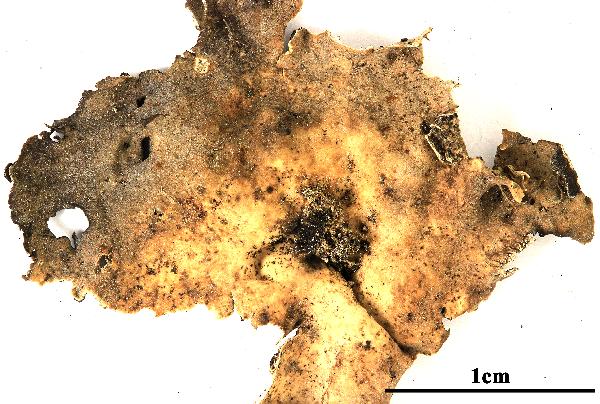

Felix Schumm - CC BY 4.0
[KU697], Honshu. Prov. Shimotsuke: Mt. Shirane. On rocks, 2570 m.
Leg. H. Shibuichi (no. 6513), 4.08.1981, det. H. Kashiwadani. EX S.
KUROKAWA AND H. KASHIWADANI: LICHENES RARIORES ET CRITICI
EXSICCATI NR. 697.

Collezione lichenologica Abramo Massalongo del Museo di Storia Naturale G. Ligabue di Venezia - Autori: Seggi, Linda; Trabucco, Raffaella Proprietà: Fondazione Musei Civici di Venezia - CC BY-NC
Italy, Veneto, M. Spina Cadubriae 1855
as Umbilicaria polymorpha var. corrugata Hoffm.
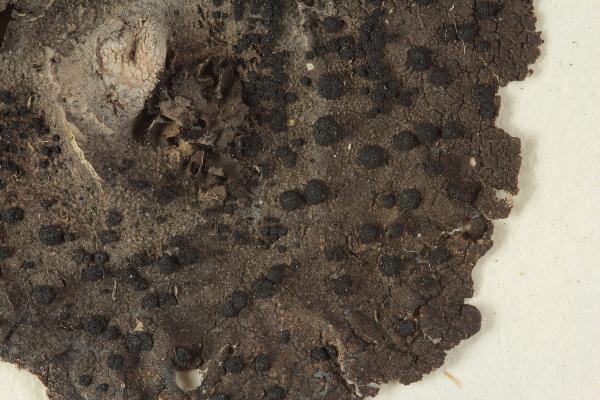
Collezione lichenologica Abramo Massalongo del Museo di Storia Naturale G. Ligabue di Venezia - Autori: Seggi, Linda; Trabucco, Raffaella Proprietà: Fondazione Musei Civici di Venezia - CC BY-NC
Italy, Veneto, M. Spina Cadubriae 1855
as Umbilicaria polymorpha var. corrugata Hoffm.
Growth form: Foliose, umbilicate
Substrata: rocks
Photobiont: green algae other than Trentepohlia
Reproductive strategy: mainly sexual
Commonnes-rarity: (info)
Alpine belt: rather common
Subalpine belt: rare
Oromediterranean belt: absent
Montane belt: absent
Submediterranean belt: absent
Padanian area: absent
Humid submediterranean belt: absent
Humid mediterranean belt: absent
Dry mediterranean belt: absent

Predictive model
| Herbarium samples |


P.L. Nimis; Owner: Department of Life Sciences, University of Trieste
Herbarium: TSB (14270)
2003/03/17
lower surface


P.L. Nimis; Owner: Department of Life Sciences, University of Trieste
Herbarium: TSB (14270)
2003/03/17


P.L. Nimis; Owner: Department of Life Sciences, University of Trieste
Herbarium: TSB (14270)
2003/03/17
apothecium


P.L. Nimis; Owner: Department of Life Sciences, University of Trieste
Herbarium: TSB (11076)
2001/12/05


Curtis Randall Björk, - CC BY-SA 4.0
Sugarbowl-Grizzly Den Provincial Park, British Columbia, Canada
September 2017


Felix Schumm - CC BY 4.0
[KU196], Japan. Honshu. Prov. Shinano: Mt. Kimpu, Minami-Sakugun. On rocks, 2550 m. Leg. H. Shibuichi (no.4668) and K. Yoshida, Umbilicaria


Felix Schumm - CC BY 4.0
[KU196], Japan. Honshu. Prov. Shinano: Mt. Kimpu, Minami-Sakugun. On rocks, 2550 m. Leg. H. Shibuichi (no.4668) and K. Yoshida, Umbilicaria


Felix Schumm - CC BY 4.0
[KU196], Japan. Honshu. Prov. Shinano: Mt. Kimpu, Minami-Sakugun. On rocks, 2550 m. Leg. H. Shibuichi (no.4668) and K. Yoshida, Umbilicaria


Felix Schumm - CC BY 4.0
[KU250], Japan. Hokkaido. Prov. Ishikari: Southern slope of Mt. Akadake, Daisetsu Mts. On rock, 2000 m. Leg. S. Kurokawa (no. 71133), 3.09.1971, det. S. Kurokawa. EX S. KUROKAWA: LICHENES RARIORES ET CRITICI EXSICCATI NR. 250.


Felix Schumm - CC BY 4.0
[KU250], Japan. Hokkaido. Prov. Ishikari: Southern slope of Mt. Akadake, Daisetsu Mts. On rock, 2000 m. Leg. S. Kurokawa (no. 71133), 3.09.1971, det. S. Kurokawa. EX S. KUROKAWA: LICHENES RARIORES ET CRITICI EXSICCATI NR. 250.


Felix Schumm - CC BY 4.0
[KU250], Japan. Hokkaido. Prov. Ishikari: Southern slope of Mt. Akadake, Daisetsu Mts. On rock, 2000 m. Leg. S. Kurokawa (no. 71133), 3.09.1971, det. S. Kurokawa. EX S. KUROKAWA: LICHENES RARIORES ET CRITICI EXSICCATI NR. 250.


Felix Schumm - CC BY 4.0
[KU250], Japan. Hokkaido. Prov. Ishikari: Southern slope of Mt. Akadake, Daisetsu Mts. On rock, 2000 m. Leg. S. Kurokawa (no. 71133), 3.09.1971, det. S. Kurokawa. EX S. KUROKAWA: LICHENES RARIORES ET CRITICI EXSICCATI NR. 250.


Felix Schumm - CC BY 4.0
[KU543], Japan. Honshu. Prov. Musashi. Mt. Ohyama, near Jumonji pass, Chichibu-gun. On rocks, 2200 m. Leg. K. Yoshida (no. 1619], 08.10.1974, det. H. Kashiwadani. EX S. KUROKAWA AND H. KASHIWADANI: LICHENES RARIORES ET CRITICI NR. 543. Thallus


Felix Schumm - CC BY 4.0
[KU543], Japan. Honshu. Prov. Musashi. Mt. Ohyama, near Jumonji pass, Chichibu-gun. On rocks, 2200 m. Leg. K. Yoshida (no. 1619], 08.10.1974, det. H. Kashiwadani. EX S. KUROKAWA AND H. KASHIWADANI: LICHENES RARIORES ET CRITICI NR. 543. Thallus


Felix Schumm - CC BY 4.0
[KU543], Japan. Honshu. Prov. Musashi. Mt. Ohyama, near Jumonji pass, Chichibu-gun. On rocks, 2200 m. Leg. K. Yoshida (no. 1619], 08.10.1974, det. H. Kashiwadani. EX S. KUROKAWA AND H. KASHIWADANI: LICHENES RARIORES ET CRITICI NR. 543. Thallus


Felix Schumm - CC BY 4.0
[KU543], Japan. Honshu. Prov. Musashi. Mt. Ohyama, near Jumonji pass, Chichibu-gun. On rocks, 2200 m. Leg. K. Yoshida (no. 1619], 08.10.1974, det. H. Kashiwadani. EX S. KUROKAWA AND H. KASHIWADANI: LICHENES RARIORES ET CRITICI NR. 543. Thallus


Felix Schumm - CC BY 4.0
[KU697], Honshu. Prov. Shimotsuke: Mt. Shirane. On rocks, 2570 m. Leg. H. Shibuichi (no. 6513), 4.08.1981, det. H. Kashiwadani. EX S. KUROKAWA AND H. KASHIWADANI: LICHENES RARIORES ET CRITICI EXSICCATI NR. 697.


Felix Schumm - CC BY 4.0
[KU697], Honshu. Prov. Shimotsuke: Mt. Shirane. On rocks, 2570 m. Leg. H. Shibuichi (no. 6513), 4.08.1981, det. H. Kashiwadani. EX S. KUROKAWA AND H. KASHIWADANI: LICHENES RARIORES ET CRITICI EXSICCATI NR. 697.

Collezione lichenologica Abramo Massalongo del Museo di Storia Naturale G. Ligabue di Venezia - Autori: Seggi, Linda; Trabucco, Raffaella Proprietà: Fondazione Musei Civici di Venezia - CC BY-NC
Italy, Veneto, M. Spina Cadubriae 1855
as Umbilicaria polymorpha var. corrugata Hoffm.

 INDEX FUNGORUM
INDEX FUNGORUM
 GBIF
GBIF
 DOLICHENS
DOLICHENS

